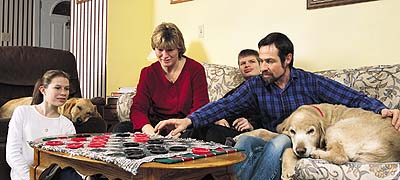 |
 |
| current issue |  |
past issues |  |
send a letter/news |  |
address update |  |
advertise |  |
about us |  |
alumni home |
Features
Messages from MiahA UNH professor teaches silent children to communicate
by Jake Chapline
photography by Lisa Nugent
 |
One afternoon last November, Karen Salter came home from work to find her 16-year-old son, Jeremiah, waiting for her in the kitchen, holding a bag of apples. He thrust the apples into her hands and rushed across the room to grab a pumpkin from the counter. "He'd been on an after-school trip to a farm, where he went on a hay ride," Karen explains. "He was so excited to tell me what he'd done. He loved going on that trip. I knew that was what he was saying."
It's not always that easy to understand Jeremiah ("Miah" to his family and friends). He doesn't talk about what he's done or what he thinks or how he feels. In fact, he doesn't talk at all. In his entire life, he has uttered only a few words. "Between the ages of 5 and 10, he occasionally used maybe eight different words," his mother says. "He'd say things like 'Hi,' 'Yeah' and 'Momma.' I think he kind of tried to talk, but realized he didn't have the words, so he gave up."
Most people who are unable to speak find other ways to communicate, using American sign language, written notes or computers, for example. None of those techniques are applicable in Miah's case. He was born with a genetic defect that severely limits not only speech, but also the ability to use alternate forms of communication. It's intensely frustrating for him and for his parents. "The worst thing is, when something is going on with Miah, we don't know what it is," says Karen. "Even though he's trying to tell us something, we have to guess what it might be.
All we can do is read his expressions."
In most respects the Salters are an entirely typical American family: Mom, Dad, two kids and two golden retrievers living in a comfortable house on a quiet street in Somersworth, N.H. Karen works part time as a medical transcriptionist for a nearby hospital, and her husband, Chris '83, is a surveyor. Miah is their oldest child. He has a 12-year-old sister, Alicia, his greatest advocate, whom he teases unmercifully.
Karen and Chris first suspected a problem when Miah was only eight months old. "Miah wasn't hitting some developmental milestones," Karen says. "He wasn't sitting up, he wasn't trying to crawl and he wasn't making any sounds." The family consulted a pediatrician, then a neurologist. Eventually Miah was diagnosed with cerebral palsy, pervasive developmental disorder and autism-like syndrome. The autism part didn't sound right to the Salters. Children with autism are characteristically withdrawn and disengaged, but Miah was the opposite. He was affectionate and sociable from an early age and seemed to be exceptionally happy. "He was Mr. Smiley from the time he was two months old," his mother observes.
When Miah was two, his parents took him to the UNH Institute on Disability's Seacoast Child Development Clinic for an evaluation by Dr. John Moeschler, a developmental pediatrician. "It looks like Angelman syndrome," Moeschler told them. The Salters had never heard of that condition, but "when we read the medical description, we said, 'That's it; that's Miah,' Karen recalls. The diagnosis was confirmed four years later at Boston Children's Hospital by a new genetic test.
Angelman syndrome was first identified in 1965 by Dr. Harry Angelman, an English physician. He had observed three children in his clinic who shared an unusual combination of symptoms, including severe developmental disabilities, seizures, problems sleeping, short attention spans, hyperactivity and a fascination with water. They had uncertain balance and poor muscle control, and they seemed unusually happy, smiling and laughing frequently, sometimes excessively. And none of them could talk.
Page: 1 2 3 Next >Easy to print version
blog comments powered by Disqus

